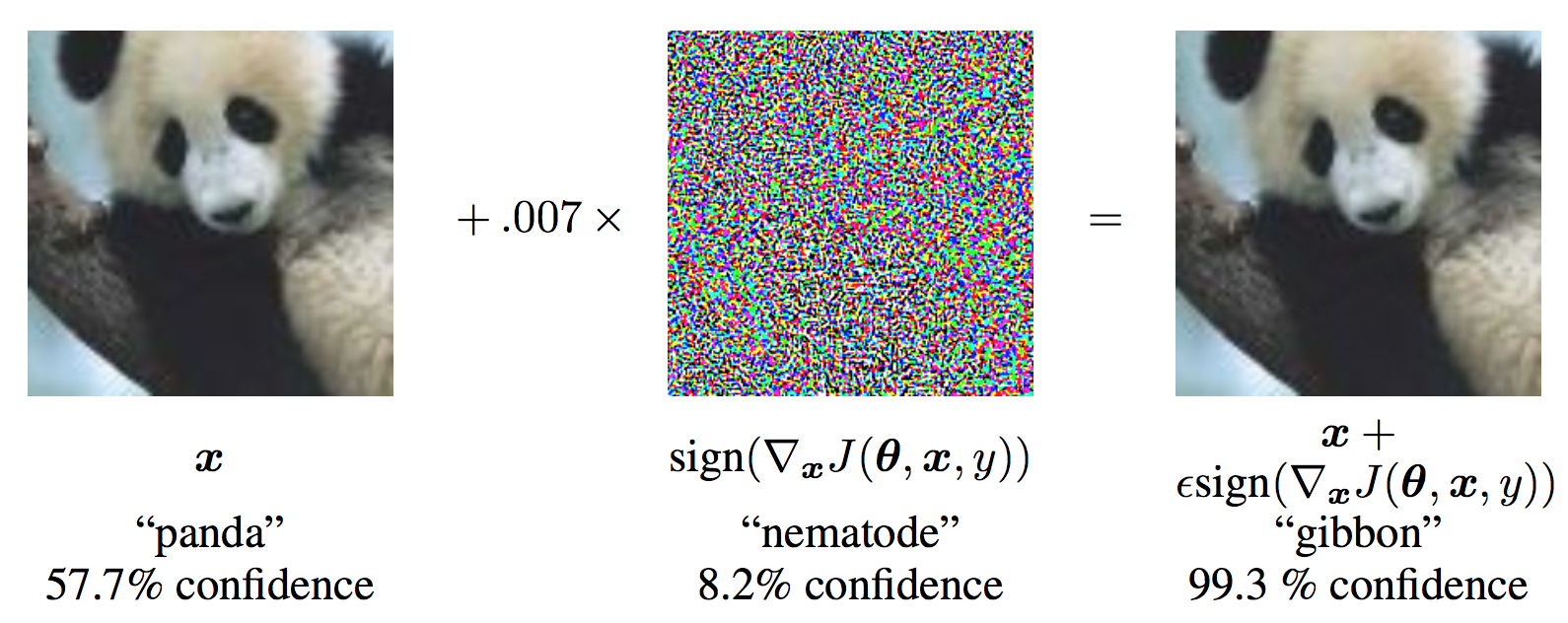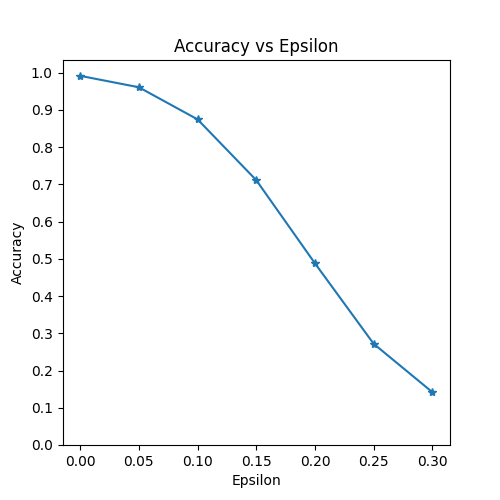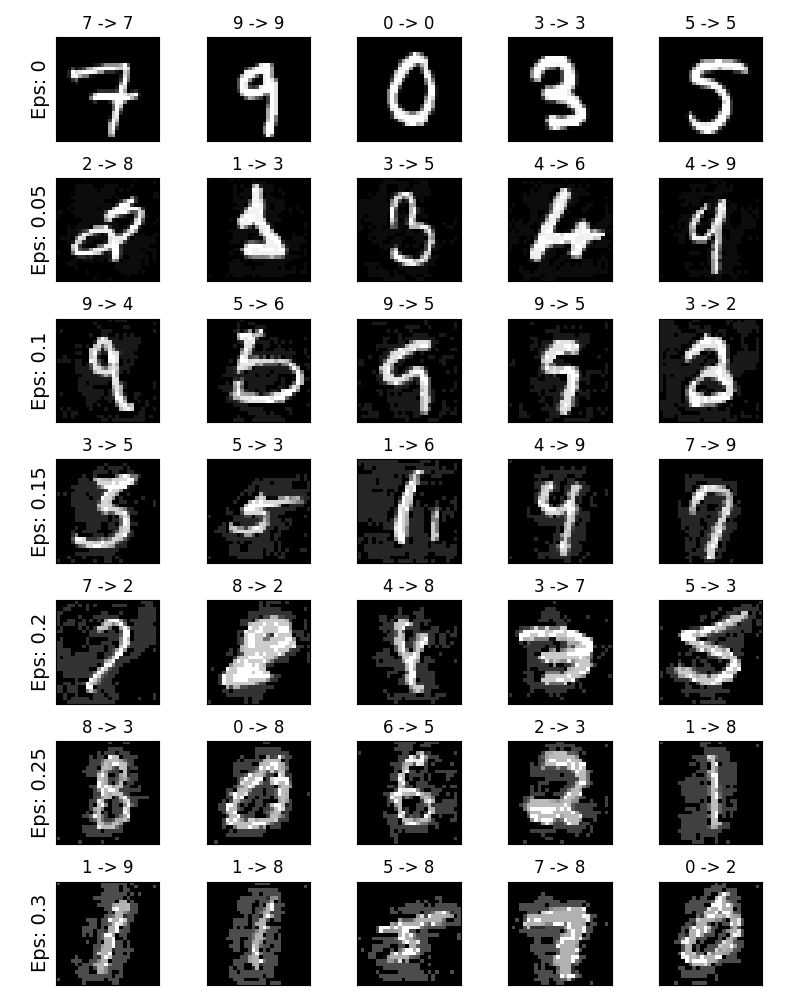注意
点击此处下载完整示例代码
对抗样本生成¶
创建时间:2018 年 8 月 14 日 | 最后更新:2025 年 1 月 27 日 | 最后验证:未验证
作者: Nathan Inkawhich
如果您正在阅读本文,希望您能理解某些机器学习模型的有效性。研究不断推动机器学习模型向更快、更准确、更高效的方向发展。然而,设计和训练模型时一个经常被忽视的方面是安全性与鲁棒性,特别是在面对希望欺骗模型的对手时。
本教程将提高您对机器学习模型安全漏洞的认识,并深入了解对抗机器学习这一热门话题。您可能会惊讶地发现,向图像添加几乎无法察觉的扰动可以导致模型性能出现巨大差异。鉴于这是一个教程,我们将通过图像分类器上的示例来探讨该主题。具体来说,我们将使用最早、最受欢迎的攻击方法之一,快速梯度符号攻击 (FGSM),来欺骗 MNIST 分类器。
威胁模型¶
从背景来看,对抗性攻击有多种类别,每种类别都有不同的目标和对攻击者知识的不同假设。然而,总的来说,最终目标是向输入数据添加最少的扰动,以导致预期的错误分类。攻击者知识的假设有几种类型,其中两种是:白盒和黑盒。*白盒*攻击假设攻击者对模型有完全的知识和访问权限,包括架构、输入、输出和权重。*黑盒*攻击假设攻击者只能访问模型的输入和输出,对底层架构或权重一无所知。目标也有几种类型,包括错误分类和源/目标错误分类。*错误分类*的目标意味着对手只希望输出分类错误,而不关心新的分类结果是什么。*源/目标错误分类*意味着对手希望改变一张原本属于特定源类别的图像,使其被分类为特定的目标类别。
在这种情况下,FGSM 攻击是一种*白盒*攻击,目标是*错误分类*。有了这些背景信息,我们现在可以详细讨论这种攻击了。
快速梯度符号攻击¶
迄今为止最早、最受欢迎的对抗攻击之一被称为*快速梯度符号攻击 (FGSM)*,由 Goodfellow 等人在Explaining and Harnessing Adversarial Examples中描述。这种攻击非常强大,而且直观。它旨在通过利用神经网络的学习方式(即*梯度*)来攻击它们。思想很简单,与其通过根据反向传播的梯度调整权重来最小化损失,这种攻击是根据相同的反向传播梯度*调整输入数据以最大化损失*。换句话说,这种攻击使用损失相对于输入数据的梯度,然后调整输入数据以最大化损失。
在我们深入代码之前,让我们看看著名的FGSM熊猫示例,并提取一些记号。

从图中可知,\(\mathbf{x}\) 是被正确分类为“熊猫”的原始输入图像,\(y\) 是 \(\mathbf{x}\) 的真实标签,\(\mathbf{\theta}\) 代表模型参数,\(J(\mathbf{\theta}, \mathbf{x}, y)\) 是用于训练网络的损失。攻击将梯度反向传播到输入数据以计算 \(\nabla_{x} J(\mathbf{\theta}, \mathbf{x}, y)\)。然后,它通过一个小的步长(图中为 \(\epsilon\) 或 \(0.007\))在最大化损失的方向(即 \(sign(\nabla_{x} J(\mathbf{\theta}, \mathbf{x}, y))\))调整输入数据。由此产生的扰动图像 \(x'\) 随后被目标网络*错误分类*为“长臂猿”,而它显然仍然是一只“熊猫”。
希望现在您已经清楚本教程的动机了,那么让我们跳入实现。
import torch
import torch.nn as nn
import torch.nn.functional as F
import torch.optim as optim
from torchvision import datasets, transforms
import numpy as np
import matplotlib.pyplot as plt
实现¶
在本节中,我们将讨论本教程的输入参数,定义受攻击的模型,然后编写攻击代码并运行一些测试。
输入¶
本教程只有三个输入,定义如下
epsilons- 用于运行的 epsilon 值列表。将 0 包含在列表中很重要,因为它代表模型在原始测试集上的性能。此外,直观上我们预计 epsilon 越大,扰动越明显,但在降低模型准确率方面攻击越有效。由于这里的数据范围是 \([0,1]\),任何 epsilon 值都不应超过 1。pretrained_model- 预训练的 MNIST 模型路径,该模型使用 pytorch/examples/mnist 训练。为了简化,请点击此处下载预训练模型。
epsilons = [0, .05, .1, .15, .2, .25, .3]
pretrained_model = "data/lenet_mnist_model.pth"
# Set random seed for reproducibility
torch.manual_seed(42)
<torch._C.Generator object at 0x7f5ee6596470>
受攻击的模型¶
如前所述,受攻击的模型与 pytorch/examples/mnist 中的 MNIST 模型相同。您可以自己训练并保存 MNIST 模型,也可以下载和使用提供的模型。这里的 *Net* 定义和测试数据加载器已经从 MNIST 示例中复制。本节的目的是定义模型和数据加载器,然后初始化模型并加载预训练权重。
# LeNet Model definition
class Net(nn.Module):
def __init__(self):
super(Net, self).__init__()
self.conv1 = nn.Conv2d(1, 32, 3, 1)
self.conv2 = nn.Conv2d(32, 64, 3, 1)
self.dropout1 = nn.Dropout(0.25)
self.dropout2 = nn.Dropout(0.5)
self.fc1 = nn.Linear(9216, 128)
self.fc2 = nn.Linear(128, 10)
def forward(self, x):
x = self.conv1(x)
x = F.relu(x)
x = self.conv2(x)
x = F.relu(x)
x = F.max_pool2d(x, 2)
x = self.dropout1(x)
x = torch.flatten(x, 1)
x = self.fc1(x)
x = F.relu(x)
x = self.dropout2(x)
x = self.fc2(x)
output = F.log_softmax(x, dim=1)
return output
# MNIST Test dataset and dataloader declaration
test_loader = torch.utils.data.DataLoader(
datasets.MNIST('../data', train=False, download=True, transform=transforms.Compose([
transforms.ToTensor(),
transforms.Normalize((0.1307,), (0.3081,)),
])),
batch_size=1, shuffle=True)
# We want to be able to train our model on an `accelerator <https://pytorch.ac.cn/docs/stable/torch.html#accelerators>`__
# such as CUDA, MPS, MTIA, or XPU. If the current accelerator is available, we will use it. Otherwise, we use the CPU.
device = torch.accelerator.current_accelerator().type if torch.accelerator.is_available() else "cpu"
print(f"Using {device} device")
# Initialize the network
model = Net().to(device)
# Load the pretrained model
model.load_state_dict(torch.load(pretrained_model, map_location=device, weights_only=True))
# Set the model in evaluation mode. In this case this is for the Dropout layers
model.eval()
0%| | 0.00/9.91M [00:00<?, ?B/s]
100%|##########| 9.91M/9.91M [00:00<00:00, 139MB/s]
0%| | 0.00/28.9k [00:00<?, ?B/s]
100%|##########| 28.9k/28.9k [00:00<00:00, 18.2MB/s]
0%| | 0.00/1.65M [00:00<?, ?B/s]
100%|##########| 1.65M/1.65M [00:00<00:00, 42.9MB/s]
0%| | 0.00/4.54k [00:00<?, ?B/s]
100%|##########| 4.54k/4.54k [00:00<00:00, 30.9MB/s]
Using cuda device
Net(
(conv1): Conv2d(1, 32, kernel_size=(3, 3), stride=(1, 1))
(conv2): Conv2d(32, 64, kernel_size=(3, 3), stride=(1, 1))
(dropout1): Dropout(p=0.25, inplace=False)
(dropout2): Dropout(p=0.5, inplace=False)
(fc1): Linear(in_features=9216, out_features=128, bias=True)
(fc2): Linear(in_features=128, out_features=10, bias=True)
)
FGSM 攻击¶
现在,我们可以定义通过扰动原始输入来创建对抗样本的函数。fgsm_attack 函数接受三个输入,image 是原始干净图像(\(x\)),epsilon 是像素级扰动量(\(\epsilon\)),而 data_grad 是损失相对于输入图像的梯度(\(\nabla_{x} J(\mathbf{\theta}, \mathbf{x}, y)\))。然后该函数创建扰动图像如下:
最后,为了保持数据的原始范围,扰动图像会被裁剪到 \([0,1]\) 的范围。
# FGSM attack code
def fgsm_attack(image, epsilon, data_grad):
# Collect the element-wise sign of the data gradient
sign_data_grad = data_grad.sign()
# Create the perturbed image by adjusting each pixel of the input image
perturbed_image = image + epsilon*sign_data_grad
# Adding clipping to maintain [0,1] range
perturbed_image = torch.clamp(perturbed_image, 0, 1)
# Return the perturbed image
return perturbed_image
# restores the tensors to their original scale
def denorm(batch, mean=[0.1307], std=[0.3081]):
"""
Convert a batch of tensors to their original scale.
Args:
batch (torch.Tensor): Batch of normalized tensors.
mean (torch.Tensor or list): Mean used for normalization.
std (torch.Tensor or list): Standard deviation used for normalization.
Returns:
torch.Tensor: batch of tensors without normalization applied to them.
"""
if isinstance(mean, list):
mean = torch.tensor(mean).to(device)
if isinstance(std, list):
std = torch.tensor(std).to(device)
return batch * std.view(1, -1, 1, 1) + mean.view(1, -1, 1, 1)
测试函数¶
最后,本教程的核心结果来自 test 函数。每次调用此测试函数都会在 MNIST 测试集上执行完整的测试步骤,并报告最终准确率。然而,请注意,此函数还接受一个 *epsilon* 输入。这是因为 test 函数报告的是受强度为 \(\epsilon\) 的对手攻击下的模型准确率。更具体地说,对于测试集中的每个样本,该函数计算损失相对于输入数据(\(data\_grad\))的梯度,使用 fgsm_attack 创建一个扰动图像(\(perturbed\_data\)),然后检查扰动样本是否是对抗性的。除了测试模型的准确率外,该函数还会保存并返回一些成功的对抗样本,以便稍后进行可视化。
def test( model, device, test_loader, epsilon ):
# Accuracy counter
correct = 0
adv_examples = []
# Loop over all examples in test set
for data, target in test_loader:
# Send the data and label to the device
data, target = data.to(device), target.to(device)
# Set requires_grad attribute of tensor. Important for Attack
data.requires_grad = True
# Forward pass the data through the model
output = model(data)
init_pred = output.max(1, keepdim=True)[1] # get the index of the max log-probability
# If the initial prediction is wrong, don't bother attacking, just move on
if init_pred.item() != target.item():
continue
# Calculate the loss
loss = F.nll_loss(output, target)
# Zero all existing gradients
model.zero_grad()
# Calculate gradients of model in backward pass
loss.backward()
# Collect ``datagrad``
data_grad = data.grad.data
# Restore the data to its original scale
data_denorm = denorm(data)
# Call FGSM Attack
perturbed_data = fgsm_attack(data_denorm, epsilon, data_grad)
# Reapply normalization
perturbed_data_normalized = transforms.Normalize((0.1307,), (0.3081,))(perturbed_data)
# Re-classify the perturbed image
output = model(perturbed_data_normalized)
# Check for success
final_pred = output.max(1, keepdim=True)[1] # get the index of the max log-probability
if final_pred.item() == target.item():
correct += 1
# Special case for saving 0 epsilon examples
if epsilon == 0 and len(adv_examples) < 5:
adv_ex = perturbed_data.squeeze().detach().cpu().numpy()
adv_examples.append( (init_pred.item(), final_pred.item(), adv_ex) )
else:
# Save some adv examples for visualization later
if len(adv_examples) < 5:
adv_ex = perturbed_data.squeeze().detach().cpu().numpy()
adv_examples.append( (init_pred.item(), final_pred.item(), adv_ex) )
# Calculate final accuracy for this epsilon
final_acc = correct/float(len(test_loader))
print(f"Epsilon: {epsilon}\tTest Accuracy = {correct} / {len(test_loader)} = {final_acc}")
# Return the accuracy and an adversarial example
return final_acc, adv_examples
运行攻击¶
实现的最后一部分是实际运行攻击。在这里,我们对 epsilons 输入中的每个 epsilon 值运行一个完整的测试步骤。对于每个 epsilon,我们还保存最终准确率和一些成功的对抗样本,以便在后续章节中进行绘制。请注意,打印出的准确率随着 epsilon 值的增加而降低。此外,请注意 \(\epsilon=0\) 的情况代表原始测试准确率,没有任何攻击。
accuracies = []
examples = []
# Run test for each epsilon
for eps in epsilons:
acc, ex = test(model, device, test_loader, eps)
accuracies.append(acc)
examples.append(ex)
Epsilon: 0 Test Accuracy = 9912 / 10000 = 0.9912
Epsilon: 0.05 Test Accuracy = 9605 / 10000 = 0.9605
Epsilon: 0.1 Test Accuracy = 8743 / 10000 = 0.8743
Epsilon: 0.15 Test Accuracy = 7108 / 10000 = 0.7108
Epsilon: 0.2 Test Accuracy = 4874 / 10000 = 0.4874
Epsilon: 0.25 Test Accuracy = 2710 / 10000 = 0.271
Epsilon: 0.3 Test Accuracy = 1420 / 10000 = 0.142
结果¶
准确率与 Epsilon 的关系¶
第一个结果是准确率与 epsilon 的关系图。正如前面提到的,随着 epsilon 的增加,我们期望测试准确率降低。这是因为更大的 epsilon 意味着我们在最大化损失的方向上迈出了更大的步长。请注意,曲线的趋势不是线性的,即使 epsilon 值是线性间隔的。例如,\(\epsilon=0.05\) 时的准确率仅比 \(\epsilon=0\) 低约 4%,但 \(\epsilon=0.2\) 时的准确率比 \(\epsilon=0.15\) 低 25%。此外,请注意,对于一个 10 类分类器,模型在 \(\epsilon=0.25\) 和 \(\epsilon=0.3\) 之间达到了随机猜测的准确率。
plt.figure(figsize=(5,5))
plt.plot(epsilons, accuracies, "*-")
plt.yticks(np.arange(0, 1.1, step=0.1))
plt.xticks(np.arange(0, .35, step=0.05))
plt.title("Accuracy vs Epsilon")
plt.xlabel("Epsilon")
plt.ylabel("Accuracy")
plt.show()

对抗样本示例¶
还记得没有免费午餐的理念吗?在这种情况下,随着 epsilon 的增加,测试准确率会下降,但扰动会变得更容易察觉。实际上,准确率下降和可感知性之间存在权衡,攻击者必须考虑这一点。在这里,我们展示了一些在每个 epsilon 值下成功的对抗样本示例。图的每一行显示不同的 epsilon 值。第一行是 \(\epsilon=0\) 的示例,代表没有扰动的原始“干净”图像。每个图像的标题显示“原始分类 -> 对抗分类”。请注意,扰动在 \(\epsilon=0.15\) 时开始变得明显,在 \(\epsilon=0.3\) 时相当明显。然而,在所有情况下,尽管添加了噪声,人类仍然能够识别出正确的类别。
# Plot several examples of adversarial samples at each epsilon
cnt = 0
plt.figure(figsize=(8,10))
for i in range(len(epsilons)):
for j in range(len(examples[i])):
cnt += 1
plt.subplot(len(epsilons),len(examples[0]),cnt)
plt.xticks([], [])
plt.yticks([], [])
if j == 0:
plt.ylabel(f"Eps: {epsilons[i]}", fontsize=14)
orig,adv,ex = examples[i][j]
plt.title(f"{orig} -> {adv}")
plt.imshow(ex, cmap="gray")
plt.tight_layout()
plt.show()

下一步做什么?¶
希望本教程能让您对对抗机器学习的主题有所了解。接下来有许多潜在的方向。这种攻击代表了对抗攻击研究的开端,此后出现了许多关于如何攻击和防御来自对手的机器学习模型的想法。实际上,在 NIPS 2017 上有一场对抗攻击和防御竞赛,竞赛中使用的许多方法都在这篇论文中有所描述:Adversarial Attacks and Defences Competition。防御工作也引出了一个更普遍的理念,即如何使机器学习模型对自然扰动和对抗性精心制作的输入更具鲁棒性。
另一个方向是在不同领域进行对抗攻击和防御。对抗性研究不限于图像领域,请查看这篇针对语音转文本模型的攻击。但也许了解对抗机器学习的最佳方法是亲自动手。尝试实现一个来自 NIPS 2017 竞赛的不同攻击,看看它与 FGSM 有何不同。然后,尝试防御模型免受你自己攻击。
另一个方向,取决于可用资源,是修改代码以支持批量、并行和/或分布式处理,而不是像上面在每个 epsilon test() 循环中那样一次处理一个攻击。
脚本总运行时间:(2 分 23.982 秒)



